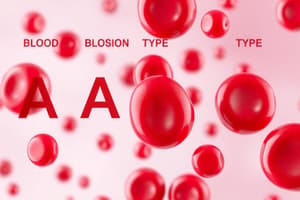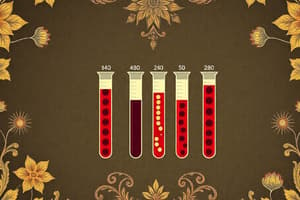Podcast
Questions and Answers
What is the purpose of forward grouping in ABO testing?
What is the purpose of forward grouping in ABO testing?
- To check for blood compatibility
- To detect antibodies in plasma
- To determine the blood type from historical data
- To identify antigens on red blood cells (correct)
What indicates a positive test result in ABO grouping?
What indicates a positive test result in ABO grouping?
- Agglutination of the red blood cells (correct)
- Absence of any reaction
- Clear plasma sample
- Presence of unusual colors in the plasma
Which testing method can reveal the presence of antibodies in the patient's plasma?
Which testing method can reveal the presence of antibodies in the patient's plasma?
- Antibody screening
- Forward grouping
- Cross-matching
- Reverse grouping (correct)
What can missing or weak reactions in the forward group suggest?
What can missing or weak reactions in the forward group suggest?
What does agglutination with an Anti-A,B reagent confirm?
What does agglutination with an Anti-A,B reagent confirm?
In the context of discrepancies, which type of reactions is considered more reliable?
In the context of discrepancies, which type of reactions is considered more reliable?
How should the results of forward and reverse ABO grouping relate to each other?
How should the results of forward and reverse ABO grouping relate to each other?
What is an example of an ABO discrepancy?
What is an example of an ABO discrepancy?
What is the result of having the cis-AB genotype?
What is the result of having the cis-AB genotype?
What effect can excessive amounts of soluble A and/or B antigen in plasma have during testing?
What effect can excessive amounts of soluble A and/or B antigen in plasma have during testing?
Which of the following methods can enhance the detection of weak ABO antigens?
Which of the following methods can enhance the detection of weak ABO antigens?
What commonly causes mixed-field agglutination in a blood sample?
What commonly causes mixed-field agglutination in a blood sample?
What is a transient cause of mixed-field agglutination observed in some patients?
What is a transient cause of mixed-field agglutination observed in some patients?
How does chimerism occur in fraternal twins?
How does chimerism occur in fraternal twins?
Which subgroup is an example of a weak ABO dominant antigen?
Which subgroup is an example of a weak ABO dominant antigen?
What is likely to happen in emergency transfusions when testing on a current sample is incomplete?
What is likely to happen in emergency transfusions when testing on a current sample is incomplete?
What is the purpose of proteolytic enzyme treatment in blood grouping?
What is the purpose of proteolytic enzyme treatment in blood grouping?
Which of the following is NOT a proteolytic enzyme used in enzyme treatment?
Which of the following is NOT a proteolytic enzyme used in enzyme treatment?
What causes rouleaux formation in red blood cells during testing?
What causes rouleaux formation in red blood cells during testing?
What is polyagglutination associated with?
What is polyagglutination associated with?
What is the role of controls of group O and autologous cells when performing enzyme treatment?
What is the role of controls of group O and autologous cells when performing enzyme treatment?
Which of the following substances can cause nonspecific agglutination in ABO tests?
Which of the following substances can cause nonspecific agglutination in ABO tests?
What might be necessary to resolve discrepancies due to Wharton’s jelly contamination?
What might be necessary to resolve discrepancies due to Wharton’s jelly contamination?
What are cryptantigens?
What are cryptantigens?
What should be done first when a discrepancy is discovered in testing results?
What should be done first when a discrepancy is discovered in testing results?
Which of the following can indicate an issue with reagents used in testing?
Which of the following can indicate an issue with reagents used in testing?
In the case of an ABO discrepancy, what might historical results indicate?
In the case of an ABO discrepancy, what might historical results indicate?
What does the presence of signs like cloudiness or color changes in reagents indicate?
What does the presence of signs like cloudiness or color changes in reagents indicate?
What issue could similar ABO discrepancies on sequential samples suggest?
What issue could similar ABO discrepancies on sequential samples suggest?
What could lead to unexpected positive reactions in the reverse group?
What could lead to unexpected positive reactions in the reverse group?
In a suspected group A or AB individual, a positive reaction with A1 cells could indicate what?
In a suspected group A or AB individual, a positive reaction with A1 cells could indicate what?
Which of the following is a condition that may produce unexpected ABO antibodies?
Which of the following is a condition that may produce unexpected ABO antibodies?
What is likely if there is a positive reaction with A1 cells and a negative reaction with O cells?
What is likely if there is a positive reaction with A1 cells and a negative reaction with O cells?
Cis-AB individuals may exhibit which characteristic in their ABO tests?
Cis-AB individuals may exhibit which characteristic in their ABO tests?
What is the recommended method to confirm suspected anti-A1 antibodies?
What is the recommended method to confirm suspected anti-A1 antibodies?
Which of the following antibodies commonly results in ABO discrepancy?
Which of the following antibodies commonly results in ABO discrepancy?
What does a positive reaction with both A1 cells and O cells suggest?
What does a positive reaction with both A1 cells and O cells suggest?
Flashcards are hidden until you start studying
Study Notes
ABO Grouping
- ABO testing includes two components: forward and reverse grouping
- Forward grouping identifies antigens by combining unknown red blood cells with known antibody (anti-A or anti-B)
- Reverse grouping identifies antibodies by combining unknown plasma with known ABO red blood cells (A1 or B)
- Agglutination (positive test) indicates the presence of the corresponding antigen or antibody
- No agglutination (negative test) indicates the absence of the corresponding antigen or antibody
- ABO blood type is determined by antigens present on red blood cells and confirmed by the correlation of forward and reverse grouping
- Anti-A,B reagent can agglutinate A, B, or AB cells, used to check forward reactions and identify subgroups
ABO Discrepancies
- ABO discrepancies occur when forward and reverse reactions do not agree
- Mixed field agglutination and inconsistent results between current and historical testing also indicate discrepancies
- Weaker reactions are more likely to be aberrant than stronger ones
Missing or Weak Reactions in the Forward group
- Subgroups of A or B: May exhibit weaker reactions
- Cis-AB genotype: Both A and B genes on the same chromosome, resulting in weak antigen expression
- Malignancies (Leukemia): May alter A or B antigens, leading to weak or missing reactions
- Soluble A or B antigens in plasma: Can neutralize reagent antiserum, causing false-negative results. Using washed cells avoids this
- Methods to enhance detection of weak ABO antigens:
- Modified testing procedures: extended incubation or enzyme treatment
- Saliva inhibition test (for secretors)
- Genetic analysis
- Mixed field agglutination: The presence of two different cell populations, often caused by transfusion of non-ABO identical cells
- Transfusion of group O red blood cells in emergencies prevents intravascular hemolysis
- ABO nonidentical bone marrow or hematopoietic progenitor cell transplantation can also result in mixed-field agglutination
- Weak ABO subgroups like A3 can cause mixed-field agglutination
- Chimerism: two different cell populations reside together after transplantation
- Mosaicism: two sperm fertilize one egg, resulting in two distinct cell populations
Enzyme Treatment for Weak Antibodies in Reverse grouping
- Use of enzymes like ficin, papain, bromelin, and trypsin can enhance weak ABO antibody reactivity
- Control cells (group O and autologous) should be treated with enzymes for accurate interpretation
Unexpected Positive Reactions in the Forward group
- Substances in plasma: Wharton's jelly, elevated globulin plasma protein, cold autoagglutinins, antibodies to antiserum constituents
- Polyagglutination: Agglutination with all plasma due to exposed antigens on the red blood cell membrane (cryptantigens)
Unexpected Positive Reactions in the Reverse group
- Acquired ABO antibodies: Due to IVIG, ABO-incompatible plasma or platelet transfusions
- Non-ABO antibodies: Cold autoagglutinins, room temperature alloantibodies, antibodies to the reverse cells' suspension medium
- Anti-A1: Can cause discrepancies in suspected group A or AB individuals
- Subgroups of A or B or cis-AB: May produce unexpected ABO antibodies and weakened antigen expression
- Distinguish anti-A1 from other cold antibodies:
- Confirming anti-A1 by phenotyping with Dolichous biflorus
- Rule out anti-A1 through phenotyping and testing against different A1 cells
Technical Errors
- Repeat testing to identify procedural errors
- Consult with your lab's procedures and reagent manufacturer's instructions
- Check reagent controls for contamination or expiration
- Cloudiness, color change, or hemolysis indicate contamination
- Check expiration dates
- Equipment problems: centrifuge calibration
- Mislabeled specimens: drawing and testing a new sample to confirm
Additional Points
- Examples provided for better understanding
- The text emphasizes importance of accurate ABO testing for transfusion safety and patient management
Studying That Suits You
Use AI to generate personalized quizzes and flashcards to suit your learning preferences.




